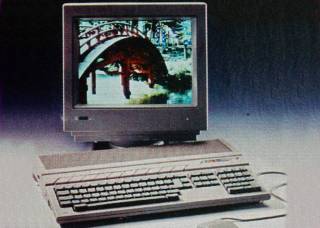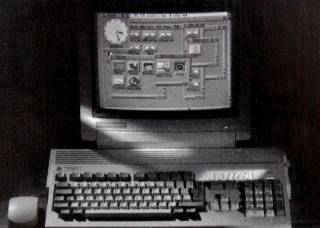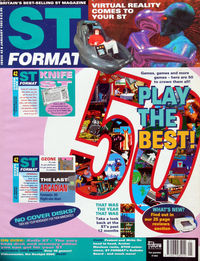

Well. sorry, but the technical specs of the 1200 don't match up to those of the Falcon - just take a look at the figures in the box in the table on the far right.
The main claim to fame for the Amiga A1200 is its high resolution HAM (HoId And Modify) mode capable of displaying 256,000 colours on-screen from a palette of 16.7 million colours. Unfortunately only static screens can be dis- played in this mode, and HAM has always been susceptible to flickering. The Falcon uses eight bits to store the data for each pixel giving a true 8-bit per pixel graphic mode and can display true colour (65,536 colours on-screen) animations at resolutions of up to 640 x 400 pixels using interlace mode.
The A1200 in HAM mode takes up to three pixels to change from one colour to another while the Falcon can change colour using a single pixel offering a higher effective resolution, and, although the A1200 offers a greater palette, it can only use up to eight bit- planes compared to the 16 bit- planes available on the Falcon. All this means is that the A1200 can display a still image at a greater resolution and with more colours, and that's all.
It has been alleged that the Falcon030 does not use ''proper'' multi-tasking, and that MultiTOS is a ''bodge'' job - that is, when one operation is being performed, other operations cease. MultiTOS is a full pre-emptive multi-tasking operating system with adaptive prioritisation with inter-process communication through MultiTOS. This means that you can run two different programs in separate windows and both can run at the same time; while you work on the program in the top window the program in the bottom window continues to process data. There may be brief halts while both applications try to access the same peripheral at the same time, but the communication between the programs gives one priority over the other preventing any software crashes.
The Falcon is provided with an FPU co-processor slot for a 68881 or 68882 maths co-processor, the A1200 has to have its FPU installed at the factory. The main processor in the A1200 is a Motorola EC68020 running at 14MHz, while the chip has embedded internal 32-bit buses, it only has an external 24-bit address bus and built-in instruction cache. The EC68020 is normally restricted to clock speeds of 16 and 25MHz, so why did Commodore use only 14MHz to run their machine? The Motorola 68030 has full 32-bit internal and external addressing along with both instruction and data caches, thus increasing the processing speed of the chip.
The Falcon runs at 16MHz making it faster than the A1200 and later versions are likely to run even faster - perhaps at 25 or 33MHz. The Motorola 68030 can run at clock speeds of 16, 20, 25, 33, 40 and 50MHz, If you combine these features with the fact that the DSP chip can process information at high speeds (16MIPS at 32KHz), 16- bit stereo sampling, 256 times oversimplify from the CODEC sound processing chip and standard connections to SCSI devices and CD-ROMS, it is plain to see that the Falcon is technically the superior machine. Unfortunately, Atari's marketing skills are another matter entirely, however.
By Clive Parker
| Feature | A1200 | Falcon |
|---|---|---|
| CPU | EC68020 | 68030 |
| Clock Speed | 14.32MHz | 16MHz |
| MIPS | 2.5 | 3.84 |
| Multi-tasking | Yes | Yes |
| FPU coprocessor socket? | No | Yes |
| Instruction cache | 256 bytes | 256 bytes |
| Data cache | No | 256 bytes |
| MMU? | No | Yes |
| Max Internal RAM | 6MBytes | 14MBytes |
| Max Video RAM | 2MBytes | 14MBytes |
| ROM | 512K | 512K |
| Complete boot from ROM? | No, disk required | Yes |
| Expansion slot | PCMCIA slot | DSP, Internal Bus Expansion |
| 16-bit true colour | No | Yes |
| True 8-bit per pixel graphics mode | No | Yes |
| Graphics Blitter | Yes | Yes |
| Independent pixel- defining in maximum colour modes? | No | Yes |
| Custom graphics chips | Yes | No |
| Max resolution | 1280 x 400 | 640 x 480 |
| Palette | 256,000 from 16.7m | 32,768 from 262,144 |
| Optional hard drive | Yes | Yes |
| Internal floppy drive | 880K | 1.44MByte |
| Stereo audio | 8-bit | 16-bit |
| Playback channels | 4 | 8 + PSO (3 additional) |
| Record channels | No | 16-bit stereo |
| Digital Signal Processor | No | Motorola 56k series |
| SCSI2 port | No | Yes |
| DSP/DMA audio port | No | Yes |
| MIDI ports | No | Yes |
| Local Area Network (LAN) | No | Yes |



